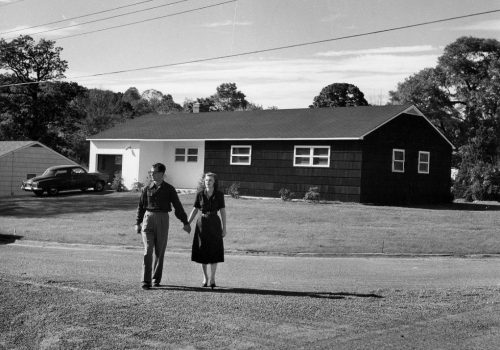The Rosella and Phillip Rolla Foundation, in Bruzella, Switzerland, currently holds an exhibition entitled American Dream with evocative photographs by major photographers who pictured the United States in the second part of the 20th century.
“The American dream was never my dream,” says collector Phillip Rolla. “I gave it up for good in 1962, when my university studies had come to an end. It happened during a meeting with some representatives from IBM, who were offering me a professional future with them. They were presenting their own version of the American dream which, at that time, was the norm. The path to success was laid out in every detail: a model wife, climbing up the company ladder and, in order to better reach the upper rungs, the total renunciation of one’s original social class. All this was described in minute detail. Faced with these expectations, I left for Turin to try to become the best artisan I could be. As far away as I could be from the American dream.”
And yet Phillip Rolla loves photographs of houses which embody the American dream, which represent that unmovable idea of promise made to everyone who, if they work hard enough, will have access to the material comforts, that is, a house, a car, education for their children, and will be better off than the previous generation. The photography collector has been so fascinated by photographs of American houses that he has collected them for many years and now has decided to exhibit them. He will exhibit these photos exactly ten years after the beginning of the most serious economic crisis to hit the world since World War II, the subprime crisis which originated in the United States. The crisis that, with the real estate market, cast aside once and for all the prophetic myth of this dream.
To the question “What do I find fascinating or enchanting in the photographs that I love?”, the Italian philosopher Giorgio Agamben replies: “Photography to me is in a way the place of the Last Judgment; it depicts the world as it appears on the last day, the Day of Wrath.” Maybe this is the Judgment on the recent economic history of the United States that is reflected in the photographs of the Rolla Collection. They seem to be beyond time, yet they contain a historical context, a date impossible to erase, the chronology of lives suspended between memory and hope, between reality and its reproduction. To show these today is to awaken consciousness, to offer an invitation to reflect on what was and what we have come to. And the Judgment is merciless.
Ten years ago, the first alarms of the collapse of the subprime mortgage crisis were sounding. The crisis that threatened the whole world with bankruptcy had begun. The Great Recession started. From one moment to the next, the liquidity in the market evaporated, and banks stopped lending money to each other. The world would be rescued by the intervention of the Central Banks injecting an amount of money never seen before in history. There were a few casualties, as reporters remind us: Lehman Brothers went bankrupt; Greece, Ireland, Spain and Portugal were rescued with billions in aid; Iceland went bankrupt and ten thousand people, according to the British Journal of Psychiatry, committed suicide.
The Dies Irae, the day of panic and wrath, was reached with the financialization of the economy and the commodification of the American dream. For years, Wall Street made it easy to buy a house by offering mortgages to millions of risky borrowers, to people who owned nothing, in order to increase the margins of both speculation and profit. The risks of these foolish investments were then spread over the market, hidden inside complicated toxic securities, bought by banks, hedge funds, pension and investment funds all over the world. This kind of operation seemed to work as long as housing prices increased; however, at the first signs of insolvency the house of cards inevitably collapsed and, with it, the American dream. The crisis spread worldwide and revealed the universal nature of this dream.
Finance begins to control American society, with the increase of social inequality which has been like a permanent pathology of the last thirty years. The working class and the middle-class crumble under the transformation of labor, the precarious nature of work and income, the industrial delocation towards low-wage countries and the digilitalization of production. It’s the end of industrial capitalism and the birth of new forms of poverty, the poverty of white people, added to the poverty of the black and Hispanic communities that has always existed.
America is not able to dream anymore. Even when the economy seems to be picking up, the United States remains sad and full of rancor. To close the distance between the real world and the values of the American dream, a man who made himself rich by real estate speculation has been elected President. It’s almost like a historical nemesis, a desperate and tragic attempt of restorative justice for the injustices suffered during the many lost years.
“I love America, that’s why I turned down the American dream.” There is method in Phillip Rolla’s love for his country; it’s found in each one of the photographs he has been collecting throughout his life. Each of them reminds us of a departure and a beginning. Each is another dream.
Christian Marazzi
Christian Marazzi is an economist and a professor at the Scuola Universitaria della Svizzera Italiana. He has taught at the State University of New York, the University of Padova, the University of Lausanne, and at the University of Genève. He is the author of numerous publications on the transformation of contemporary capitalism.
American Dream
October 7 to December 10, 2017
Rosella and Phillip Rolla Foundation
La Stráda Végia (ex via Municipio)
6837 Bruzella
Switzerland
















